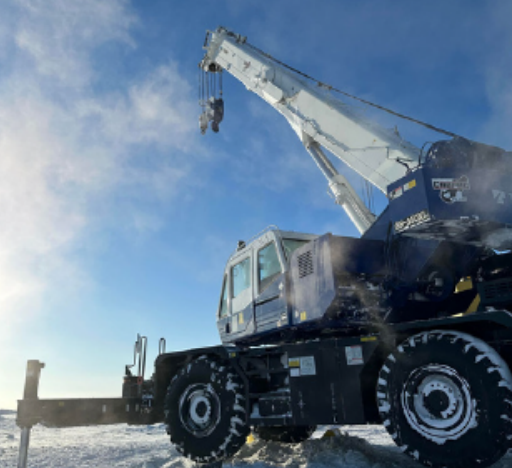
News
Cranes
Cropac Equipment, SGP Repairs and Tadano work together to assemble a GR350XL-3 rough terrain crane in Nunavut
April 5, 2024 By Mike Lacey
 Cropac Equipment, SGP Repairs and Tadano worked together to assemble a GR350XL-3 rough terrain crane in Nunavut. Photo: Cropac Equipment
Cropac Equipment, SGP Repairs and Tadano worked together to assemble a GR350XL-3 rough terrain crane in Nunavut. Photo: Cropac Equipment How does one assemble a rough terrain crane in Canada’s far north?
It requires comprehensive planning, the necessary resources and the proper expertise.
In early 2023, Cropac Equipment facilitated the sale of five Tadano rough terrain cranes for use in Northern Canada’s Nunavut and Northwest Territories regions.
According to Cropac Equipment, the customer decided one of those cranes, a GR350XL-3 model, would be disassembled at the Yellowknife airport and transported to the job site by a Hercules plane.
SGP Repairs was tasked with reassembling the crane on-site and restore its operational functionality. The work was done in collaboration with Cropac Equipment and Tadano.
Cropac Equipment notes the job had several challenges.
First, the crane components were exposed to the elements for approximately two months, resulting in snow covering everything.
Second, assembling a crane in a remote environment with extreme cold conditions presented logistical hurdles, and required careful planning, co-ordination and execution.
SGP worked closely with Tadano America Corporation and Cropac Equipment as it assessed thecondition of the crane components and the site. Following that, the company developed a detailed plan for the assembly process. The plan had to consider the freezing temperatures, the rugged terrain and other factors.
SGP had several requirements for assembly. The company needed to bring in skilled personnelwith expertise in crane assembly and operation, as well as support staff to assist with logistics and site management.
As well, crane parts, tools and equipment for assembly were required. This included hoisting machinery, lifting devices, fasteners and protective gear suitable for extreme cold conditions. Finally, SGP also required vehicles to navigate the terrain and transport the assembled crane to its final location.
Despite daily temperatures of -40 to -50 degrees Celsius and difficult ground to work on, the crew was able to successfully assemble the crane. Once assembled, tests were performed. On the crane to ensure it met all applicable standards.
Print this page